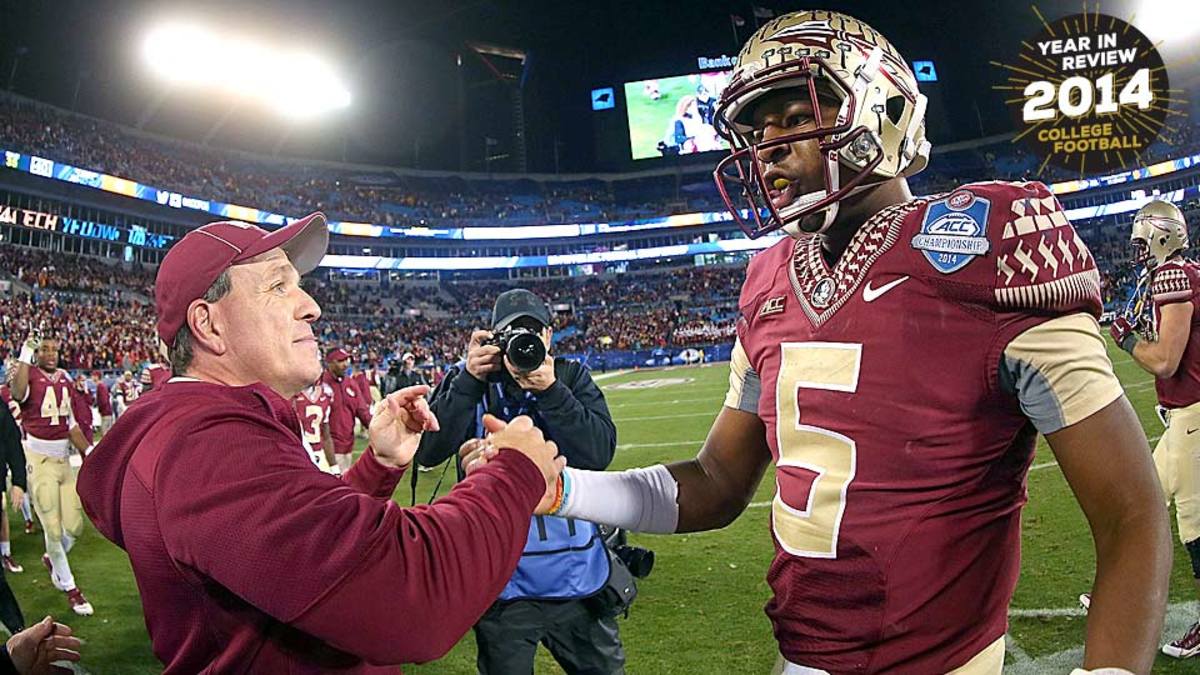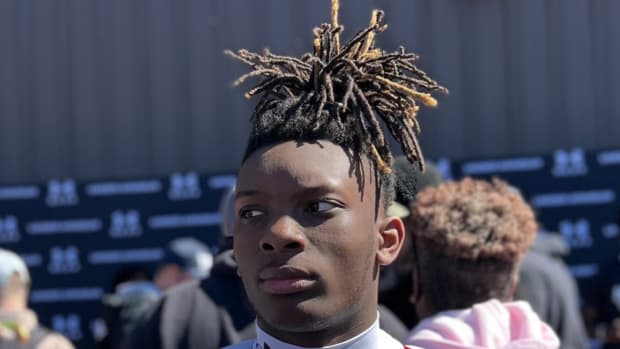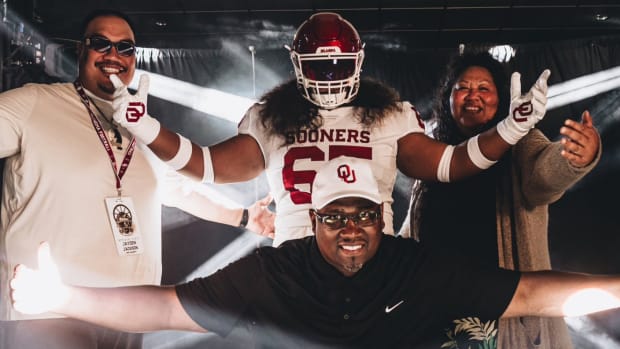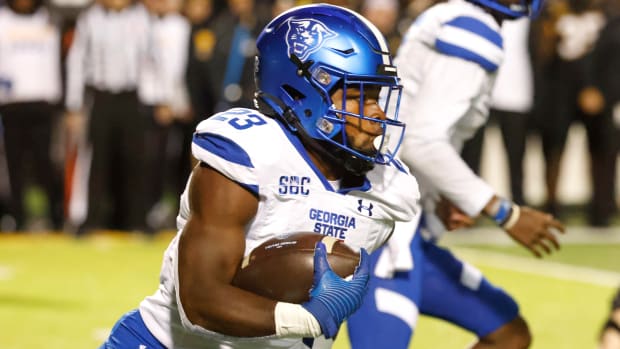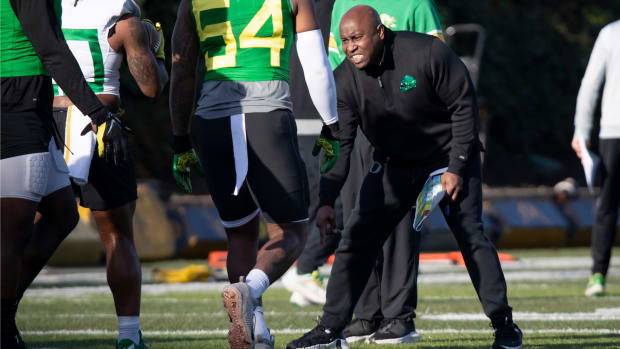SI's 10 favorite things in CFB this year
College football was all about change in 2014. There was a whole new playoff system put in place. Schools left conferences to join other conferences. Coaches were hired and fired, and several forces were set in motion that will continue to shape the landscape for years to come, even if we can’t fully comprehend what they all mean just yet.
Looking back on a year is always tricky: Some things that seemed crucial in the moment ended up being relatively minor, while others that were discounted in real time ended up being huge. Here are my 10 favorite stories from 2014.
1. Welcome to the playoff era.
The College Football Playoff was seemingly all anyone could talk about this season. The questions were endless: How will this loss affect a team’s chances? Did that team schedule enough key nonconference matchups to make the field? Is the selection committee biased? I had never heard the words Grapevine or game control mentioned so frequently in my life.
Four teams will compete for the national championship this postseason, whereas before there were only two. But the weekly rankings and endless discussion the new system generated sometimes felt like overkill. Debate does that to anything. However, when we see those semifinal games on New Year’s Day, the reality will sink in and we’ll all be happy.
• BECHT: Reviewing how wrong we were in first playoff season
2. The pay-for-play debate rages on.
This was the year fans felt like they needed a law degree to understand what was going on around the sport. Between the Ed O’Bannon trial, the Jeffrey Kessler case and the Northwestern players’ union movement, courts played a significant role in molding college football’s future.
My biggest takeaway? The public is pushing for student-athletes’ rights more fervently than ever before. After Georgia tailback Todd Gurley was suspended for accepting money in exchange for autographs, fans finally appeared fed up. And with former West Virginia athletic director Oliver Luck -- on record as saying student-athletes should be compensated for their name, image and likeness rights -- set to take a high position in the NCAA, things could get crazy soon.
3. Oregon finally gets over the hump.
For years the Ducks seemed on the verge of competing for a national championship. But they always got tripped up (recently by Stanford) in a deep Pac-12. In 2013 Josh Huff and De’Anthony Thomas went so far as to say they didn’t want to play in another Rose Bowl unless it was for the title; naturally, Oregon didn’t even reach Pasadena last year, instead routing Texas in the Alamo Bowl.
Things are different now. With the playoff, Marcus Mariota’s Heisman Trophy season and an improved defense, the Ducks are finally set to play for the sport's biggest prize. Of course, they'll have to go through the Rose Bowl to get there.
4. Rise of the freshman running backs.
It’s a good time to be a freshman tailback. While redshirt freshman quarterbacks took the nation by storm in recent seasons (see: Johnny Manziel and Jameis Winston), young, dynamic backs were the breakout stars of 2014.
There was Oklahoma’s Samaje Perine, who broke Melvin Gordon’s single-game FBS rushing record with his 427-yard rushing performance against Kansas. There were Oregon’s Royce Freeman and Florida State’s Dalvin Cook, who will face off in the Rose Bowl on Jan. 1. And don’t forget about Georgia’s Nick Chubb, who thrived in a starting role after Gurley was suspended and later injured, or LSU’s Leonard Fournette, Tennessee’s Jalen Hurd and Arizona’s Nick Wilson. It’s not just the top teams that boast young studs, either. Western Michigan’s Jarvion Franklin ran for 1,525 yards with 24 touchdowns.
5. Florida State: The team that just wouldn’t lose.
Call them zombies. Call them villains. Call them whatever you would like. It won’t faze the Seminoles. Everyone kept predicting Florida State’s downfall this season. Yet the ‘Noles are 13-0 with an ACC championship and an impressive 29-game winning streak.
Florida State wasn’t as dominant as it was last year, but it was, as coach Jimbo Fisher put it after a 37-35 win over Georgia Tech on Dec. 6, “amazing.” The ‘Noles had close calls against almost every opponent on their schedule, and memorable finishes in wins over Clemson, Notre Dame, Boston College, Miami and others. The Seminoles didn’t make things easy, but that’s why they were one of this year’s must-watch teams every week.
• McCANN: What's next in Jameis Winston's legal saga?
6. The Big 12’s “One True Champion” problem.
Who knew the phrase “61-58” would mean so much and so little at the same time? The Big 12 had two very good one-loss teams this season, Baylor and TCU. The only problem: According to the league, both were champions.
The Big 12 lacks a conference title game. Since it has only 10 members, NCAA rules prevent it from staging one. And normally that wouldn’t be a problem. Playing every team in a true round-robin format should be enough. This fall, however, the Bears -- who beat TCU 61-58 on Oct. 11 -- and the Horned Frogs each lobbied for inclusion in the inaugural playoff, using a variety of tactics. It proved costly. Amid the Big 12 bickering, one-loss Ohio State crushed Wisconsin in the Big Ten title game to snag the final spot when the field was announced.
7. Mississippi, center of the football universe.
It came and went so fast that it almost feels like a dream. For a couple of weeks this season, Mississippi was the most important state in college football. After Ole Miss upset Alabama 23-17 and Mississippi State beat Texas A&M 48-31 on Oct. 4, the two teams were tied at No. 3 in the AP Poll. By Week 8, Mississippi State had climbed up to No. 1 and Ole Miss was still at No. 3.
The Bulldogs remained unbeaten until Nov. 15, when Alabama topped them in Tuscaloosa. When everything was said and done, neither Mississippi team made the playoff. Still, that shouldn’t take away from the season either program had. They will both play in prestigious bowls (Ole Miss in the Peach Bowl and Mississippi State in the Orange Bowl), and we’ll always have the memories of Katy Perry throwing corn dogs on ESPN’s CollegeGameDay and students dragging the goalposts around Oxford.
8. Lane Kiffin: Phoenix rising.
The jokes wrote themselves after Kiffin was hired as Alabama’s new offensive coordinator. He was supposed to fail miserably. The onetime boy wonder, fired at an airport and knocked back down to the assistant level, could never coexist with Nick Saban. Then a funny thing happened. The arrangement not only worked, but it also became one of the primary reasons the Crimson Tide reached the playoff.
Kiffin turned a quarterback controversy post-AJ McCarron into an opportunity, as Blake Sims transformed into a dangerous starter. Meanwhile, wide receiver Amari Cooper thrived in a new scheme. The traditional Alabama running game even got a much-needed injection of creativity. Kiffin will likely get another head coaching job at some point, but this season showed why he was so highly regarded in the first place. The guy can flat-out call plays.
9. Ohio State’s quarterback carousel.
Think back to the middle of August (Aug. 20, to be exact). Imagine Ohio State cracking the top four without Braxton Millerand his backup. It seems inconceivable, right? Well, that’s a testament to the job Urban Meyer and offensive coordinator Tom Herman (now Houston's new head coach) were able to do this season.
Miller went out with a shoulder injury, and redshirt freshman J.T. Barrett played like one of the best quarterbacks in the country. He seemed set to head to New York as a Heisman finalist before disaster struck in the Michigan game, when Barrett was lost for the remainder of the season with a fractured ankle. Enter third-stringer Cardale Jones, who looked plenty competent leading Ohio State to a blowout win over Wisconsin in the Big Ten title game. The Buckeyes not only survived after injuries to their quarterbacks, they thrived.
• THAMEL: Ohio State in good hands with QB Cardale Jones
10. The Power Five gets autonomy.
This story flew under the radar a bit, but it has the potential to drastically affect, well, everything in college football. First the basics: In August the NCAA board of directors voted to adopt a new governance model, allowing the Power Five conferences to operate with autonomy. This was a long time coming, as each of the Power Five commissioners had mentioned their desire for this over the last year. The Group of Five commissioners had expressed concerns about the divide this would create.
As things stand now, this model means student-athletes in Power Five conferences are heading toward receiving full grant-in-aid and cost-of-attendance scholarships, and other benefits could soon follow. It remains too early to predict what is next, but this is a huge move for college athletics, no matter which side you’re on.
